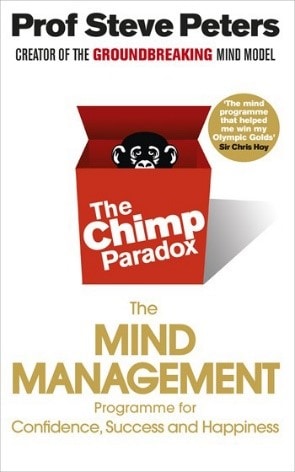In a nutshell: Too busy to read the best-selling book, The Chimp Paradox by Prof Steve Peters accredited as the mind programme that helped Sir Chris Hoy win his Olympic gold medals then read this short summary review by Gary Edwards.
Too busy to read this …

Then read this …
The testimonials are incredibly impressive. Stephen Gerrard attributes his best form with Liverpool and England to Prof Peters, Dave Brailsford at Team Sky cycling describes him as a “genius”, Ronnie O’Sullivan claims the techniques greatly improved his life and a Deputy Headteacher from Burgess Hill is quoted as saying this book is “inspirational and should be an essential component in every teacher’s toolkit”
So what is the big secret in this programme for Confidence, Success and Happiness?
Our Professor starts with a very easy to understand description of the psychological mind system part of the human brain. And it is easy to get though, Peters does, inevitably for a Consultant Psychiatrist, point out that the whole thing is a lot more complex!
In essence Peters says we can view the psychological mind as made up of three independent component parts; the Chimp, the emotional machine that responds very quickly to stimulus, thinks independently of us and can trigger thoughts and feelings that can be either constructive or destructive, the Human, that rational, analytical part of the brain that processes information in a considered, factual way before eliciting action and then there is the Computer where information including experiences and learned behaviours are stored for future reference.
The most important thing to understand, for Peters is that our Chimp is given to us and like owning a dog we have to understand and learn how best to control it. The Chimp is far quicker to receive and act on information and stimuli than the Human and it is somewhat of a paradox in that the Chimp can be either your best friend or worse enemy and sometimes both at the same time.
Your Chimp will operate with a ‘jungle mentality’, it will rely on instincts and drives, quickly going into Flight, Fight or Freeze mode when sensing change or danger. Peters uses the example of going into a room full of strangers. Some Chimps will simply turn and flee feeling threatened and insecure, some will freeze finding social interaction difficult and causing high anxiety whilst others will go into fight mode and seek to establish their presence with confidence. The trick here is to enable the Human to step in, assess the situation calmly and factually to enable a more rational, appropriate course of action.
Peters offers some ideas of how best to train your Chimp. The most obvious one is through Rewards so that when your Chimp wants you to react in a dysfunctional way you guide it to more productive behaviour with a positive reward. The example Prof Steve Peters gives is knowing your room is urgent need of redecoration but there is an offer to socialise with a friend, the latter being the obvious lure for Chimp behaviour. The answer is to invite your friend around to help paint your room thereby achieving the Human’s needs while rewarding the Chimp with the “banana” of having some fun and interaction with your friend at the same time. A simplistic example obviously but it does get the message across.
Probably the most useful strategy in this book is the development of mind-sets in your Computer. Mind-sets are wired into our brains by consistent repetition of positive behaviours (auto-pilots) or by negative messages (gremlins) and will form a reference set of default behaviours.
The best and most applicable example of this is in the form of what Peters describes as the Snow White Mind-set which leads to the “innocent, passive victim at the hands of others and circumstances and completely devoid of all responsibility and accountability”.
This person will avoid accountability for decisions, will not accept responsibility for their own unhappiness, will view themselves as incapable of changing destiny and will constantly express just how unfair everyone is through continual sighs and gestures. A typical response from a Snow White to a genuine question of “what’s wrong?” will be “oh nothing” or “I shouldn’t have to tell you!” as when challenged Snow White will either become passively aggressive or react in a cold – anger accusatory way.
And there will be many reading this who will have encountered this mind-set at work.
So what is the solution?
Well, Prof Steve Peters starts by encouraging us to understand how this mind-set has formed. A historical embedding of gremlins, series upon series of negative messages reinforcing low self-worth and personal lack of control over events, things are continually done to this person.
And so the process needs to be reversed using Human brain thinking so that Snow White can see how he/she is working, how they are presenting themselves to others and the impact of what they do is evident. It is about enabling the victim to see that actually they do have a choice about how they behave and that this can influence outcomes but also that happiness is also a choice and assertiveness accepting responsibility are normal adult behaviours
Clearly in a book of 356 pages there is a lot more to it than the brief summary above and, for me there was a fair bit of padding and repetition but on balance I’m with the Deputy Head from Burgess Hill and I would strongly recommend putting this on your New Year’s resolution to read more often.
Alternatively (or as well) you can find out more about how to control your Chimp, how to develop your Human brain to get involved more quickly but more importantly how to develop appropriate, practical strategies to deal effectively with Snow White and the other dysfunctional mind-sets and gremlins on our training course: Resilience and Mindfulness.
Gary Edwards
December 2016